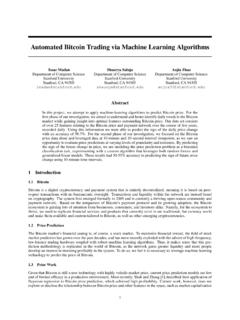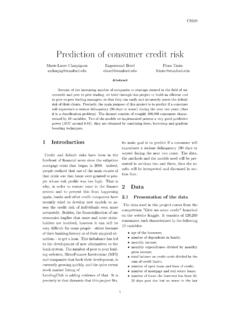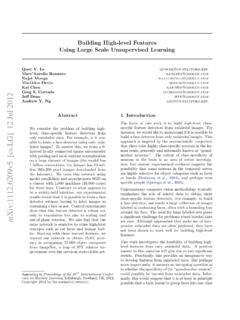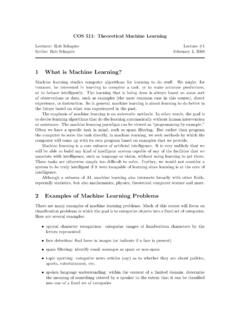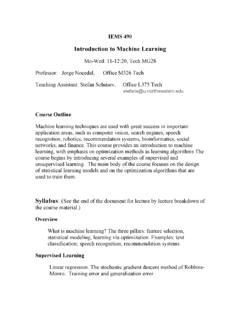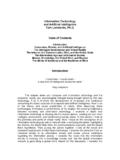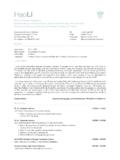Transcription of Railway and ICT (Information and Communication …
1 22 Japan Railway & Transport Review No. 67 Mar 2016 Railway and ICT ( information and Communication technology )Innovation in Railway Maintenance utilizing information and Communication technology (Smart Maintenance Initiative)Mitsunobu Takikawapost-war population increase and high-economic-growth era. But changes to the economic structure with falling population, diversifying values, and globalization, mean conventional ways of doing business no longer apply, and not even large corporations can rest that are growing recently are creating new business models using the latest ICT. For example, a manufacturer of photocopiers successfully switched from manufacturing and selling photocopiers to a new business leasing model, making large profits (Figure 1). This new business model was successful because advances in ICT allow the company to identify the operational status of individual photocopiers at low cost, enabling maintenance before failures.
2 This can be said to be the IntroductionInformation and Communication technology (ICT) is advancing at a tremendous pace in recent years, and is set to change the social environment and composition of industry. The Industry national project started in Germany in April 2013 is attempting to create a fourth industrial revolution to change the composition of Germany s manufacturing industry using the Internet of Things (IoT) and big-data technology . In March 2014, the Industrial Internet Consortium was launched by the private sector in the USA with participation of big companies, such as GE, IBM, Intel, Cisco, and AT&T. This plan also uses IoT and big data-related technologies to make industry as a whole smarter, and maintenance more and sell productsCollect fees according to usage and maintenanceFigure 1 Change of Business ModelWith major changes to global society using ICT, Japan s railways too must change proactively to become the transportation mode chosen by society in this new environment.
3 The Research and Development Center of the JR East Group has proposed a Smart Maintenance Vision so as not to fall behind in these changes, and is working on R&D for innovation of Railway maintenance. This article introduces trends in ICT and the Smart Maintenance Vision along with case examples of R&D currently under Social Conditions in JapanJapan s population is already declining. Its industry experienced many past successes in high-quality monozukuri (manufacturing) by mass-production amidst the 23 Japan Railway & Transport Review No. 67 Mar 2016 Railway and ICT ( information and Communication technology )result of changing from tangible manufacturing to intangible services, utilizing ICT at the at Railway maintenance from the same perspective, the function of conventional R&D has been to break from 3D (dangerous, difficult, dirty) work and reduce equipment maintenance costs.
4 For example, in the area of tracks, low-maintenance tracks (Figure 2) and the like have been developed to mechanize inspection and repair so as to reduce the need for maintenance. This has reduced failures and human errors using a tangible approach. However, railways face a major change in the social environment, so maintenance must change too. Looking at case examples in other industries, intangible approaches will be Trends in ICTThis section covers trends in ICT and discusses ideas for future Railway maintenance. Internet of Things (IoT)IoT is a method for enabling things to exchange information via the Internet. In the future, we may exchange information based on data gathered via sensors while being unaware that the other side is a machine; Machine to Machine (M2M) is another term with similar meaning but the IoT concept includes people as things.
5 The main purpose of M2M is to increase efficiency by automatic control of machines, aiming for a smart society. IoT has come to the focus of attention due to the increase in devices and sensors that can be carried by people and the creation of a ubiquitous communications environment. For example, smartphones have many sensors, such as GPS (Global Positioning System) receivers and accelerometers, in addition to telephone and email functions. It is no exaggeration to say they are full-fledged all-purpose sensors with communications functions, and it is amazing that such devices can be purchased for less than 100,000 (approximately US$850).IoT is already being used for purposes such as monitoring aircraft flights and automobile status. For example, in the aviation industry, sensors throughout the aircraft monitor the status during flight.
6 The large volumes of data are analyzed and used to identify signs of failures in advance. In railways, embedding sensors in rolling stock and mechanical equipment would enable similar Data AnalyticsBig-data analytics has been used in recent years in areas such as online shopping recommendation functions and social network analysis. In IT companies and among experts, big data means more than just lots of data, and is interpreted as data leading to knowledge that is helpful in corporate management and business and in people s lives. Big data includes diverse types as shown in Figure 3, including text information typified by tweets and similar social networking services (SNS), photos and videos, logs generated when accessing websites and the like, and information from various sensors. The data volume amounted to Zettabytes (ZB) ( 1021 bytes) in 2012, and is expected to grow 14-fold to 40 ZB in addition to services, there are expectations for big data technologies in the maintenance field.
7 The problem of aging infrastructure built during Japan s high economic growth era has come into focus, and the Ministry of Wide sleeperCement-filled layerNonwoven fabricFigure 2 Low-maintenance Track24 Japan Railway & Transport Review No. 67 Mar 2016 Internal Affairs and Communications (MIC) estimates that the economic impact of preventive maintenance on road bridges will be 270 billion. Bridges, tunnels, and other structures are maintained for railways as well because they are part of the social infrastructure. Like roads, applying big-data analytics technologies to maintenance work should bring about new industries and help make maintenance more Intelligence (AI)Research on AI started in the 1950s, and rule-based expert systems were in the spotlight in the 1980s. These expert systems were an attempt to express the complexity of the real world by rules alone, but they ended in failure.
8 Reflecting the lessons learned, current AI has become closer to the thought patterns of humans by ignoring rules for data input and speculating on results by statistical processing. Recent examples of AI are Watson, which beat the champion of a famous American TV quiz programme in 2011, and Ponanza, which beat a professional shogi (Japanese chess) player in an official match in AI systems are based on machine learning where humans teach answers. That machine learning evolved further with Deep Learning developed by Stanford University and Google in the USA in 2012. Deep Learning successfully obtained the concept of a cat from images on a network without being taught by humans. In other words, AI became able to learn on its own without relying on humans to build knowledge. This Deep Learning technology is used not only in image recognition, but also as voice recognition technology in smartphones and knowledge of AI including Watson and Ponanza is a database where past knowledge is accumulated.
9 In Railway maintenance, past data gained from periodic inspections and reports of incidents is stored on many systems. If this data could be utilized effectively, there is a high possibility that we could build AI with abilities greater than veteran Surrounding Railway BusinessThis section describes issues related to future maintenance in terms of the environment surrounding JR East s Railway business. First, we organize issues from the standpoint of maintenance costs, and second, from the makeup of Maintenance ExpensesFigure 4 shows the changes over time in Railway equipment maintenance costs and Figure 5 shows the changes in capital investment. Maintenance costs have not changed much since 1988 after the privatization of Japanese National 2012 ZettabytesSmartphonesSensorsE-moneyLocat ionsPOS SystemsEmailsTweetsVideosPhotosTablets20 2040 Zettabytes90% to 95%5% to 10%Temporarydata (discarded)Permanent stored data5247 Gigabytes per personFigure 3 Future Data Volumes25 Japan Railway & Transport Review No.
10 67 Mar 2016 Railway and ICT ( information and Communication technology )05010 0150200250300350400450 Investment cost Financial year198719891991199319951997199920012003 20052007200920112013 System changeSafety Renewal(billon yen)OthersLifestyle servicesStation servicesBetter transportFigure 5 Investment Costs02004006008001000120014001600180020 00 CostFinancial year198719891991199319951997199920012003 20052007200920112013 Oper ati ng cos tMai ntenance cos t(billon yen)Figure 4 Maintenance Costs26 Japan Railway & Transport Review No. 67 Mar 2016 Railways (JNR), making up between 25% and 33% of overall Railway operating costs. Overall Railway capital investment has been around 200 billion since privatization, but has been increasing in recent years. Capital investment declined in 2011 as a result of the Great East Japan Earthquake and tsunami.




